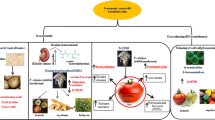Abstract
Mutation breeding has been used for improving oligogenic and polygenic characters, disease resistance and quantitative characters including yielding ability. The cytological stability of maize inbred lines is an important consideration in view of their extensive use in genetics and plant breeding research. Investigation in Zea mays L. confirms that the migration of chromosomes is a real event that cannot be misunderstood as an artifact produced by fixation or mechanical injuries. During present investigation, we found that out of six inbred lines of Zea mays L. viz. CM-135, CM-136, CM-137, CM-138, CM-142 and CM-213 at various treatment doses of gamma irradiations viz. 200, 400 and 600 Gy, some of the plants of inbred line CM-138 at 200 Gy dose displayed characteristic cytoplasmic connections during all the stages of meiosis. Four plants from this treatment set were found to be engaged in a rare phenomenon reported as “Cytomixis”. It elucidates that in inbred of Zea mays L., induced cytomixis through gamma rays treatment may be considered to be a possible source of production of aneuploid and polyploid gametes. This phenomenon may have several applications in Zea mays L. improvement in the sense of diversity and ever yield potential.
Similar content being viewed by others
References
Singh, B.D., Plant Breeding, Principle and Methods, 4th ed., New Delhi: Kalyani Publ., 1990.
Sheidai, M., Azarani, H., and Hosseininejad, Z., Cytogenetic Study of Gamma Irradiated Lines of Cotton (Gossypium hirsutum L.), J. Sci., Islam. Republ. Iran, 2002, vol. 13(4), pp. 311–322.
Latoo, S.K., Khan, S. Bamotra, and Dhar, A.K., Cytomixis impairs meiosis and influences reproductive success in Chlorophytum comosum (Thumb) Jacq.- an additional strategy and possible implications, J. Biosci., 2006, vol. 31, no. 5, pp. 629–637.
Falistocco, E., Lorenzetti, S., and Falcinelli, M., Microsporogenesis in Desynaptic Mutant of Dactylis, Cytologia, 1994, vol. 59, pp. 309–316.
Sheidai, M., Vafai-Tabar, M., Mirzai-Nedoshan, H., and Hosseni-Nejad, Z., Cytogenetical Studies in Gossypium hirsutum L. Cultivars and Their Hybrids, Cytologia, 1998, vol. 63, pp. 41–48.
Bedi, Y.S., Cytology in Woody Species, Proc. Indian Acad. Sci. (Plant Sci.), 1990, vol. 100, pp. 233–238.
Bellucci, M., Roscini, C., and Mariani, A., Cytomixis in Pollen Mother Cells of Medicago sativa L., J. Hered., 2003, vol. 94, pp. 512–516.
Srivastava, P.K. and Raina, S.N., Cytomixis in Clitona temantea L. var. pleniflora Fantz. f. pleniflora, Curr. Sci., 1980, vol. 49, pp. 824–835.
Zheng, G.C., Yang, Q., and Zneng, Y., The Relationship between Cytomixis, Chromosome Mutation and Karyotype Evolution in Lily, Caryologia, 1987, vol. 40, pp. 243–259.
Marechal, R., Quelques observations sur le phenomene de cytomixie chez. Gossypium, Bull. Inst. Agron. Gembloux, 1963, vol. 31, pp. 223–240.
Kumar, G. and Srivastava, U., Cytomictic Variation in Isabgol (Plantago ovate forsk), Nucleus, 2001, vol. 44, pp. 180–182.
Kumar, G. and Sharma, V., Induced Cytomixis in Chick Pea (Cicer arietinum L.), Nucleus, 2002, vol. 45, pp. 24–26.
Bhatt Tariq Ahmad, Sahba Parveen, and Ainul Haq Khan, MMS-Induced Cytomixis in Pollen Mother Cells of Broad Bean (Vicia faba L.), Turk. J. Bot., 2006, vol. 30, pp. 273–279.
Koul, K.K., Cytomixis in Pollen Mother Cells of Alopecurus arundinaceus Poir., Cytologia, 1990, vol. 55, pp. 169–173.
Dagne, K. Meiosis in Interspecific Hybrids and Genomic Interrelationships in Guizotia Cass (Compositae), Hereditas, 1994, vol. 121, pp. 119–129.
Bione, N.C.P., Pagliarini, M.S., and De Toledo, J.F.F., Meiotic Behavior of Several Brasilian Soybean Varieties, Genet. Mol. Biol., 2000, vol. 23, no. 3, pp. 623–631.
Ghanima, A.M. and Talaat, A.A., Cytomixis and Its Possible Evolutionary Role in Kuwait Population of Diplotaxis harra (Boraginaceae), Bot. J. Linn. Soc., 2003, vol. 143, pp. 168–175.
Koernicke, M., Uber ortsveranderung von Zellkarnern SB Niederhein, Ges. Natur-U Heilkunde Bonn A., 1901, p. 14–25.
Miehe, H., Uberdie Wanderung des Pflanzlichen Zellkernes Flora, 1901, vol. 88, pp. 105–142.
Pagliarini, M.S. and Pereira, M.A.S., Meiotic Studies in Pilocarpus pennatifolius Lem. (Rutaceae), Cytologia, 1992, vol. 57, pp. 231–235.
Consolaro, M.E.L. and Pagliarini, M.S., Cytomixis in Pollen Mother Cells of Centella asiatica (L.) Urban., Nucleus, 1995, vol. 38, pp. 80–85.
Souza, A.M. and Pagliarini, M.S., Cytomixis in Brassica napus var. oleifera and Brassica campestris var. oleifera (Brassicaceae), Cytologia, 1997, vol. 62, pp. 25–29.
Caetano-Pereira, C.M. and Pagliarini, M.S., Cytomixis in Maize Microsporocytes, Cytologia, 1997, vol. 62, pp. 351–355.
Kaul, M.L.H. and Nirmala, C., Male Sterile Gene Action Diversity in Barley and Pea, Nucleus, 1991, vol. 34, pp. 32–39.
Kamra, O.P., Chromatin Extrusion and Cytomixis in Pollen Mother Cells of Hordeum, Hereditas (Lond.), 1960, vol. 46, pp. 592–600.
Amma, C.K.S., Namboodiri, A.N., Panikkar, A.O.N., and Sethuraj, M.R., Radiation-Induced Male Sterility in Hevea brasiliensis (Wild ex Adr. de Juss) Muell., Agr. Cytologia, 1990, vol. 55, pp. 547–551.
Nirmala, C. and Kaul, M., Male Sterility in Pea. IV, Cytologia, 1994, vol. 59, pp. 195–201.
Haroun, S.A., Al Shehri, A.M., and Al Wadie, H.M., Cytomixis in the Microsporogenesis of Vicia faba L. (Fabaceae), Cytologia, 2004, vol. 69, pp. 7–11.
Pierozzi, N.I. and Benatti, R., Jr., Cytological Analysis in the Microsporogenesis of Ramie, Boehmeira nivea Gaud. (Urticaceae) and the Effect of Colchicines on the Chiasma Frequency, Cytologia, 1998, vol. 63, pp. 213–221.
Boback, M. and Herich, R., Cytomixis As a Manifestation of Pathological Changes after the Application of Trifluraline, Nucleus, 1978, vol. 20, pp. 22–28.
Basavaiah, D. and Murthy, T.C.S., Cytomixis in Pollen Mother Cells of Urochloa panicoides P. Beauv. (Poaceae), Cytologia, 1987, vol. 52, pp. 69–74.
Sarvella, P., Cytomixis and the Loss of Chromosome in Meiotic and Somatic Cells of Gossypium, Cytologia, 1958, vol. 23, pp. 14–24.
De Mantu and Sharma, A.K., Cytomixis in Pollen Mother Cells of an Apomictic Ornamental Ervatamia divericata (Linn) Alston, Cytologia, 1983, vol. 48, pp. 201–207.
Maheshwari, P., An Introduction to the Embryology of Angiosperms, New York: McGraw-Hill, 1950.
Author information
Authors and Affiliations
Corresponding author
Additional information
The article is published in the original.
About this article
Cite this article
Rai, P.K., Kumar, G. & Tripathi, A. Induced cytomictic diversity in maize (Zea mays L.) inbred. Cytol. Genet. 44, 334–338 (2010). https://doi.org/10.3103/S0095452710060022
Received:
Published:
Issue Date:
DOI: https://doi.org/10.3103/S0095452710060022




